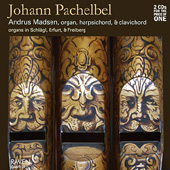
ESSENTIAL RECORDINGS

If it wasn't for the famous, or infamous, (depending on your opinion of it) Canon in D, the name Johann Pachelbel
(1653-1706) would probably only be found in dusty text books on university library shelves. But thanks to devoted musicians and
organists like Andrus Madsen, we hear concrete evidence that Pachelbel was much more than a one hit wonder.
A gifted German organist and composer, he had an important influence on the development of music leading into the high Baroque.
Although he lived in the south of Germany, he spent many years in the north where he befriended Johann Bach, Johann Sebastian's
father, and brought with him the warmth, lyricism and influence of the Italian style from the south, which had a beneficial effect
on the strict structures of the northern organ school. His chorale preludes in particular are very well written and most likely had
a major influence on Johann Sebastian Bach's own output in the genre.
The instruments that organist Andrus Madsen chose for this recording are the Austrian 1634 Andreas Putz organ, repaired and
expanded in 1708 by Johann Christoph Egedacher, and finally restored in 1989 by Reil of the Netherlands. The German 1652
Ludwig Compenius organ, altered in the 1750s and eventually rebuilt by Rühle Orgelbau in 2000. The German 1735 Gottfried
Silbermann organ, restored as recently as 2007 by the Jehmlich Orgelbau and Orgelwerkstatt Wegscheider firms of Dresden. A
1990 "ravalement" style Flemish Double Harpsichord built by Robert Hicks, and a 1974 Christopher Clarke Double-Fretted
Clavichord.
Toccata in e, PWC 462
Prelude in g, PWC 410
Fuga in C "Nachtigall," PWC 131
Toccata in g, PWC 467
Fantasie in g, PWC 128
Warum betrübst du dich, PWC 484
Es spricht der unweisen Mund wohl, PWC 114
Durch Adam’s Fall is ganz verderbt, PWC 104
Suite in e, PWC 436
(Prelude [improvised], Allemande, Courante, Sarabande, Double, Gigue)
Prelude in a [improvised]
Fuga in a, PWC 163
Fugue in D, PWC 153
Ich ruf zu dir Herr Jesu Christ, PWC 42
Ein feste Burg ist unser Gott, PWC 106
O Lamm Gottes unschuldig, PWC 393
Was mein Gott will das g'scheh allzeit, PWC 488
An Wasserflüssen Babylon, PWC 17
An Wasserflüssen Babylon (Weimar ms.)
Magnificat Octavi Toni, PWC 353, 356, 349, 347
Ciaccona in d, PWC 41
Toccata in F, PWC 464
Toccata in g, PWC 468
Fuga in g, PWC 160
Gelobet seist du Jesu Christ, PWC 166
Toccata in C, PWC 457
Fuga in C, PWC 151
Fantasie in E-flat, PWC 127
Wenn wit in höchsten Nöten sein, PWC 494
Fuga in d, PWC 154
Vom Himmel hoch, PWC 52
Wie schön leuchtet den Morgenstern, PWC 501
Suite in g, PWC 443
(Prelude [improvised], Allemande, Courante, Sarabande)
Christus der ist mein Leben, PWC 376
Suite in g, PWC 442
(Allemande, Courante, Ballet, Sarabande, Gigue)
Toccata in g, PWC 466
Fuga in c, PWC 152
Herr Gott dich loben alle Wir, PWC 183
O Mensch bewein dein Sünde groß, PWC 396
Wo Gott zum Haus nicht gibt sein Gunst, PWC 512
Toccata in F [improvised]
Magnificat sexti toni, PWC 334, 326
Toccata in F, PWC 463
As you can see, the list of works gathered together on this double CD is impressive, and each and every piece is a fine example
of how keyboard music was evolving at the time. It seems that many of his works were improvised, which might determine why
the harmonic development and detailed counterpoint is not as complex and finely-tuned as Bach's own work, especially in the
fugues. But some of his chorale preludes are very well conceived. The O Lamm Gottes unschulding, PWC 393
in particular, performed here on the Compenius organ, is a beautiful example of the genre and compares well with any that Bach
himself may have composed. The Suite in E minor, PWC 436 is another great example of keyboard music
from the time, and in this recording, it helps demonstrate how fine an instrument the Robert Hicks
harpsichord is. The Ciaccona in D minor, PWC 41 is a remarkable example of the art of improvisation from
that period, and brings forward the qualities of the Putz organ. The bold Toccata in F, PWC 464
with its virtuosic, improvised runs over long-sustained pedal notes, again shows off both the organ and the organist. The mournful
Fantasie in E-flat, PWC 127 in which Andrus Madsen brings out the beautiful flute stops
of the Compenius instrument. And these are but a handful of the great organ works on this recording.
American organist Andrus Madsen, himself a gifted improviser, breathes life into these extemporaneous pieces,
searching out each one's unique qualities, and using the instrument best suited to highlight those qualities. And of course, the
excellent recording from Raven, specialists in organ music recording technology, in turn highlights each
instrument's qualities. Highly recommended for all organ music fans and collectors alike!
Jean-Yves Duperron - October 2010